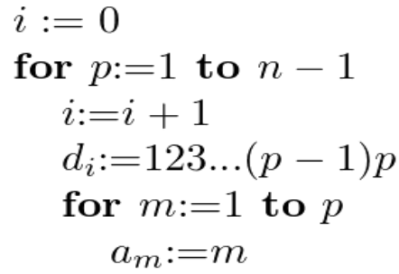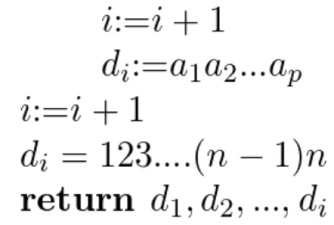Unit-3
Counting Principles
Question-1: In how ways can be drawn an ace or a king from an ordinary deck of playing cards?
Sol.
Number of Aces in a pack = 4
Number of kings in a pack = 4
Number ways an Ace or a king can be drawn from the pack = 4 + 4 =
Question-2: Define product rule
Sol.If  ,
,  , …, En are events, and E can happen in
, …, En are events, and E can happen in  ways
ways  can happen
can happen  ways, …
ways, …  can happen in
can happen in  ways, then the sequence of events E, first followed by
ways, then the sequence of events E, first followed by  followed by
followed by  , …, followed by
, …, followed by  can happenin m1 × m2 × … × mn ways
can happenin m1 × m2 × … × mn ways
Question-3: Define permutation.
Sol.
The arrangement of a set of n objects in a given order is called a permutation.
Any arrangement of any  of these objects in a given order is said to be r-permutation.
of these objects in a given order is said to be r-permutation.
The number of permutations of n objects taken r will be denoted as-
P(n, r)
Formula-

Question-4: Three cards are chosen one after the other from a 52-card deck. Find the number m of ways
This can be done: (a) with replacement; (b) without replacement.
Sol.
(a) Each card can be chosen in 52 ways. Thus m = 52(52) (52) = 140 608.
(b) Here there is no replacement. Thus the first card can be chosen in 52 ways, the second in 51 ways, and the third in 50 ways. So that-
P(52, 3) = 52(51)(50) = 132600
Question-5: A box contains 10 light bulbs. Find the number n of ordered samples of:
(a) Size 3 with replacement,
(b) Size 3 without replacement.
Solution:
(a) n= 
(b) P (10, 3) = 10 × 9 × 8 = 720
Question-6: Define combinations and its properties.
Sol. A combination of n objects taken at a time is an unordered selection of r of the n
Objects (r ≤n).
A combination of n objects taken r at a time is also called r-combination of n objects.
The number of combinations is given by-
C(n, r)
Note-
1. property-1

2. property-2

3. property-3

Question-7: Find the term containing  in the expansion of
in the expansion of 
Sol.
The general term will be-

Put 8 – 2r = 4 we get r = 2
Therefore the term contains is-
is-

Question-8: Expand 
Sol.
Here we have-
By using binomial theorem, we get


Question-9: Find the number of ways of placing 8 similar balls in 5 numbered boxes.
Solution:
The number of ways of placing similar balls in 5 numbered boxes is
= C (5 – 1 + 8, 8)
= C (12, 8) = 495
Question-10: How many outcomes are possible by costing a 6 faced die 10 times?
Solution:
This is same as placing 10 similar balls into 6 numbered boxes.
There are C (6 – 1 + 10, 10)
= C (15, 10) possible outcomes.
Question-11: Describe an algorithm for generating all the combinations of the set of the n smallest positive integers-
Sol.


